In the late 1930s, a famous radio program in the USA called War of the Worlds — a story line that proposed an attack on the earth from Mars — created a sensation and instilled fear into the listening audience. Those were simpler times and ours is — hopefully — a more sophisticated and global situation. However, the proposition of attacks on the homeland is no less cogent today. My purpose in this presentation is not to scare anyone, but to provoke strategic dialogue using a totally theoretical scenario — generated in keeping with the overall theme of this conference — by computer.
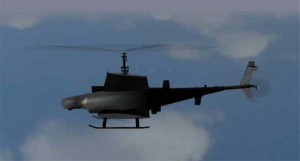 My colleagues and I have set the venue close to home — perhaps uncomfortably so — to make a point: it could happen here! For the purposes of this presentation, the setting is an attack from the sea against the west coast of India targeting the high value and critically important oil drilling facilities of the Bombay High and the nuclear facilities at Trombay. The scenario underscores the requirement for “intelligence, reconnaissance and surveillance” — ISR if you will — as important contributions to national security. It also highlights the role that netcentric operations play in maximizing efficiency while minimizing — I use this last term advisedly — cost. The whole purpose of netcentricity, as we all know, is to make the best use of available assets.
My colleagues and I have set the venue close to home — perhaps uncomfortably so — to make a point: it could happen here! For the purposes of this presentation, the setting is an attack from the sea against the west coast of India targeting the high value and critically important oil drilling facilities of the Bombay High and the nuclear facilities at Trombay. The scenario underscores the requirement for “intelligence, reconnaissance and surveillance” — ISR if you will — as important contributions to national security. It also highlights the role that netcentric operations play in maximizing efficiency while minimizing — I use this last term advisedly — cost. The whole purpose of netcentricity, as we all know, is to make the best use of available assets.
While several of the tactical ISR elements I have chosen to portray as nodes on the netcentric mechanism are — or are modeled after — Northrop Grumman surveillance systems, this is not meant to be a sales pitch and you will find very little technical data in the presentation. The emphasis will be on what is required to maintain vigilance and security of vital sea-land interfaces and crucial installations. Northrop Grumman just happens to be in the forefront of this challenge.
We have learned from the events of Nine Eleven and more recently — and closer to home — how hard it is to predict random acts of terrorism. In just the last few weeks, latter day pirates in the waters off Somalia boarded and seized a merchantman and held the crew and contents for ransom. While not “terrorism” per se, the incident provoked responses from countries around the Indian Ocean littoral and the Government of India has dispatched a frigate to participate in the international effort to control piracy.
The meat of the presentation is taken from a modeling and simulation exercise developed by our Cyber Warfare Integration Network to test the reaction and planning skills of the players in the exercise. Before I run the scenario, a word about what you will see. It may all look like entertainment or a training film for operators, but what it is in the hands of the “modelers” is a planning tool that can be manipulated behind the scenes to see whether plans make sense or need modification. The viewers in a war game can be challenged or second-guessed to make whatever point the planners want to emphasize.
The simulation you will be seeing is the animated portion of the overall simulation. Analytical data is being generated by these models that can be stored, replayed, or even repeated using slightly different weapon parameters. In addition to analytical studies, tools such as the CWIN can be used for training of senior officers in the decision-making process. While every real-world scenario is unique and calls for sound judgment based on the individual situation, the use of computer simulation, such as CWIN, can be used to explore alternatives and the grounds for operational-level professional discussion.
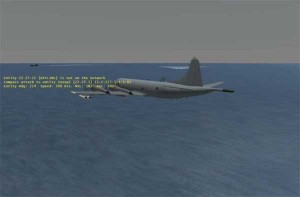 In the scenario we have chosen to portray today, we have posited that an “innocent” merchantman is on the high seas bent on creating an incident — and inflicting damage — on a vital Indian installation. Let’s just say that the targeted installation is an oil platform in the Bombay High or, more ominously, the Homi Bhabha Research Center at Trombay. Our Navy [and Coast Guard] has no way of knowing which among the many ships innocently plying the crucial Arabian Sea/Indian Ocean waterway is the “bad guy”. Our scenario today portrays what is needed among the available technologies to — hopefully — sort out the wheat from the chaff and prevent the attack that our intelligence services believe to be imminent.
In the scenario we have chosen to portray today, we have posited that an “innocent” merchantman is on the high seas bent on creating an incident — and inflicting damage — on a vital Indian installation. Let’s just say that the targeted installation is an oil platform in the Bombay High or, more ominously, the Homi Bhabha Research Center at Trombay. Our Navy [and Coast Guard] has no way of knowing which among the many ships innocently plying the crucial Arabian Sea/Indian Ocean waterway is the “bad guy”. Our scenario today portrays what is needed among the available technologies to — hopefully — sort out the wheat from the chaff and prevent the attack that our intelligence services believe to be imminent.
The story opens with an overview of the sea-land interface emphasizing the multitude of potential targets. We see the depiction of a couple of radar sweeps symbolizing what probably are numerous surveillance assets — friendly and otherwise — that inhabit the nearby seas on a routine basis. But how do we pick out the bad guy from the welter?
This is where the nodes on the netcentric capability come into play. It is difficult to display visually the abstract web of communications that constitute “netcentricity”. Let’s just stipulate that they are there and concentrate on the hardware that provides the eyes and ears of a meaningful intelligence, reconnaissance and surveillance — ISR — system.
A modern and meaningful ISR system comprises of manned and unmanned platforms and I will introduce them to you in no particular order. The first is a vertical takeoff unmanned aerial vehicle — VTUAV — symbolized by the Fire Scout. The US Navy is in the advanced stages of acceptance testing of the Fire Scout B-model that will become operational in the maritime services next year.
The VTUAV is the new “close examination” asset in the maritime surveillance kit. It can operate – takeoff and land – from the smallest seaborne helicopter platform day or night, even in heavy weather. My remarks, of course, focus on the attributes and capabilities of the Fire Scout, but many of these same attributes would be common to any VTUAV using currently available designs and technologies. The main features of these systems are persistence and reach, low noise and visible signature and above all, simplicity. Competent VTUAV design forgoes many of the crew-protection redundancies extant in manned helicopters — no need since there are no humans aboard. The human fatigue factor is also avoided. The newest VTUAV designs can carry a multiplicity of payloads — SAR radar, electro-optical and IR sensors, laser designators, etc. They do the job of close examination of potential targets — down to reading the names and registrations of maritime targets for positive IDs. What is perhaps even more attractive is the relative ease of maintenance of current-generation VTUAVs. Fire Scout, for example, requires only one hour of maintenance per flight hour, unheard of in the helicopter community from which I come.
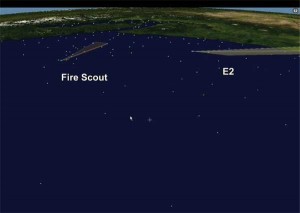 Apart from the present scenario, VTUAVs provide an ideal solution for the “other” maritime security adjuncts: the Coast Guards, customs services and other waterborne police organizations. Here again, small size, reduced personnel and maintenance requirements, etc, make the VTUAV the ideal platform for drug interdiction, search-and-rescue and anti-pollution patrols.
Apart from the present scenario, VTUAVs provide an ideal solution for the “other” maritime security adjuncts: the Coast Guards, customs services and other waterborne police organizations. Here again, small size, reduced personnel and maintenance requirements, etc, make the VTUAV the ideal platform for drug interdiction, search-and-rescue and anti-pollution patrols.
Next we go to the opposite end of the end of the sophistication and lethality spectrum: the tactical aircraft that will be the instrument for execution of the tactical response plan – that will take out the “bad guy” once he is singled out from the many other targets in the area of operations. We have chosen to show the US Navy’s F/A-18 in this role since it is a multi-purpose tactical aircraft well-known to the Indian Navy from joint maneuvers [like the just-completed Malabar exercise for this year] and is under consideration by the Indian Air Force as the future Medium Multirole Combat Aircraft. It could have as easily been the Indian Navy’s current Harrier jumpjet or the IAF’s Su-30.
The F/A-18 was selected also because it has a proven role as a node on the netcentric spectrum. Northrop Grumman and the US Navy recently collaborated on a test of netcentricity that involved the F/A-18 Hornet along with Fire Scout, the E-2 Hawkeye [about which more later] and a simulated aircraft carrier that offered “proof of concept” of these communications linkages now considered vital for national security operations and which, after all, are the focus of much of this conference.
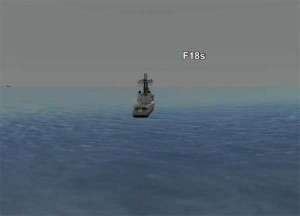 Also playing in our scenario today is the workhorse of low and medium altitude surveillance of the maritime environment: the multi-engined, long-endurance antisubmarine warfare platform that also functions in the surface monitoring role. We have chosen the P-3 which is still the US Navy’s ASW aircraft — and that of many other naval forces throughout the world. It could just as easily have been the Il-38 or the An-142 in service with the Indian Navy or the developmental P-8 which both the US Navy and the Indian Navy have chosen for their next-generation assets in this regard. The ASW mission generally requires operation at lower altitudes to optimize the capabilities of the magnetic anomaly and sonar buoy submarine detection capabilities of the platform. Low-and-slow somewhat limits their utility in long-range surface detection, but their large capacity and crew size make them ideal platforms for flexibility and command-and-control as a contribution to netcentricity.
Also playing in our scenario today is the workhorse of low and medium altitude surveillance of the maritime environment: the multi-engined, long-endurance antisubmarine warfare platform that also functions in the surface monitoring role. We have chosen the P-3 which is still the US Navy’s ASW aircraft — and that of many other naval forces throughout the world. It could just as easily have been the Il-38 or the An-142 in service with the Indian Navy or the developmental P-8 which both the US Navy and the Indian Navy have chosen for their next-generation assets in this regard. The ASW mission generally requires operation at lower altitudes to optimize the capabilities of the magnetic anomaly and sonar buoy submarine detection capabilities of the platform. Low-and-slow somewhat limits their utility in long-range surface detection, but their large capacity and crew size make them ideal platforms for flexibility and command-and-control as a contribution to netcentricity.
Enter the fixed wing unmanned aerial vehicle. This is the primary platform in the “everybody-does-it” sweepstakes. The Israelis, of course, are the past masters of the fixed wing UAV technology, especially in the smaller categories. But we read almost daily of the exploits of the Predator armed and unarmed surveillance drones in the antiterrorist operations along the Durand Line. Other UAVs range from tiny, hand-held and launched tactical “snoopy” drones to the ultra-high-altitude platforms like Northrop Grumman’s own Global Hawk. In our scenario today, the fixed wing UAV is the “bad guy’s” vehicle of choice as you will see.
And then there is the vessel [or vehicle] of interest or VOI, the proverbial needle in a haystack that our intrepid “netcentrists” must locate in order to prevent the calamity that is the focus of our fictional, but entirely plausible scenario.
Finally, tying it all together, as you have already seen it in the preamble — we have the E-2 Hawkeye. This is the proverbial eye-in-the-sky, which though it has been around for awhile in one avatar or another, is still without equal in the situational awareness field. The next-generation E-2D is just now completing advanced testing preparatory to entering production for the US Navy and international customers.
It is the “top cover” for the netcentric continuum, simultaneously viewing the aerospace environment from the surface to the stratosphere a full 360 degrees around. Maximized automation favors the small necessary crew and small crews mean reduced costs. Though designed to be flown from big-deck aircraft carriers, Hawkeye is equally at home operating from fixed bases, a capability that is being expanded in the new generation through increased fuel-carrying capacity and an aerial refueling capability.
We join the scenario with friendly forces searching for the threat vessel amongst many neutral or “white” vessels. The first goal is to find the Vessel of Interest (VOI), and then stop the threat. You will see how the resources can be used to find, fix, and target the threat. The vessel of interest is a standard commercial tanker that has been seized and taken over by the “enemy”. The vessel has all the signatures of a typical merchantman: from speed and tonnage to radar signature.
The team leader of the portrayed scenario is the E-2 Hawkeye which maintains radar contact with all the players, guides the fighters to an attack solution and provides command and control for the entire operation.
The search begins for the vessel of interest which is hiding amongst the hundreds of neutral coastal vessels. The Fire Scout and the E-2 operate in a coordinated and integrated partnership.
The E-2 begins to ID and track all the vessels.
Vessels that are suspect are investigated at closer quarters by the Fire Scout. Also note that in the scenario, we can model environmental phenomena such as clouds or rain. The container ship appears to be neutral, not our “bad guy”. Note that you are seeing the actual sensor feed that is being generated by the computer model.
Here is a depiction of the Fire Scout radar display.
The entire radar picture is networked and we begin to separate the wheat from the chaff. Note the red icon. It looks like our vessel has been located!
The Fire Scout moves in for a closer look while staying a “safe” distance from the vessel.
The P-3 is guided toward the VOI by the E-2 — as a show of force — and under the watchful eye of both the Hawkeye and the Fire Scout.
A Coast Guard cutter is directed toward the vessel by the E-2.
The quality of the Fire Scout electro/optical sensor can even detect personal moving about the deck of the ship. It also detects the generic fixed wing UAV about to be launched.
The enemy UAV launches and flies toward it target: either an oil platform or the nuclear facility on the mainland.
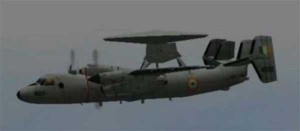 The Hawkeye detects the launch and directs the fighter against the threat.
The Hawkeye detects the launch and directs the fighter against the threat.
A positive ID is established and the fighter launches an air-to-air missile which destroys the UAV.
Meanwhile, the Hawkeye keeps the tanker under constant surveillance, backed up by the P-3, until the cutter can arrive on the scene. End of scenario!
In summary, while I hope that our little show has captured your interest, it is important to bear in mind that tremendous amounts of data are being generated and captured for each depicted platform. The information thus generated becomes integral to the overall objective of maritime domain awareness and allows the day-to-day planners to “place in the can” contingency plans to facilitate timely response to an emergency. The key to maritime security is the ability — to the maximum extent possible — to anticipate the unexpected in a very unpredictable world.




